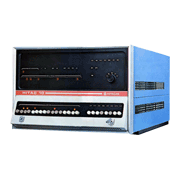The HITAC 10 was Japan's first minicomputer, developed by Hitachi and announced in February 1969. It had a 16-bit word architecture (32-bit words were optional). All circuit elements were implemented in ICs, and magnetic core was used for the memory unit. The system had memory capacity ranging from 4 Kword to a maximum 32 Kword, a cycle time of 1.4 microseconds, an addition/subtraction arithmetic speed of 2.8 microseconds, 16 basic instructions (up to 12 instructions could be added as an option), and could be connected to a maximum of 64 input/output devices. The system was equipped with a data typewriter as a basic input/output device, and paper tape was used as a portable storage media. A double-precision arithmetic mechanism was used for scientific and engineering computation. The available software included a monitor (early OS functions), assembler, compilers (FORTRAN, BASIC) and various input/output subroutines, and software development efficiency was high. The machine was used for a wide range of applications due to it distinctive features -- such as compactness, low price, high-reliability and ease of software creation. In addition to personal use in scientific and engineering calculation, it was widely used as a built-in controller for monitoring and control, automatic control, production line control, control of machine tools and robots, drafting/design via plotter control, and data communication control, and in instruments for gas chromatography, fluorescence analysis and blood analysis. In the basic configuration with typewriter, it cost ¥4.95 million.

- Home >
- Historical Computers in Japan >
- Minicomputers >
- HITAC 10
All Rights Reserved, Copyright (C) Information Processing Society of Japan

